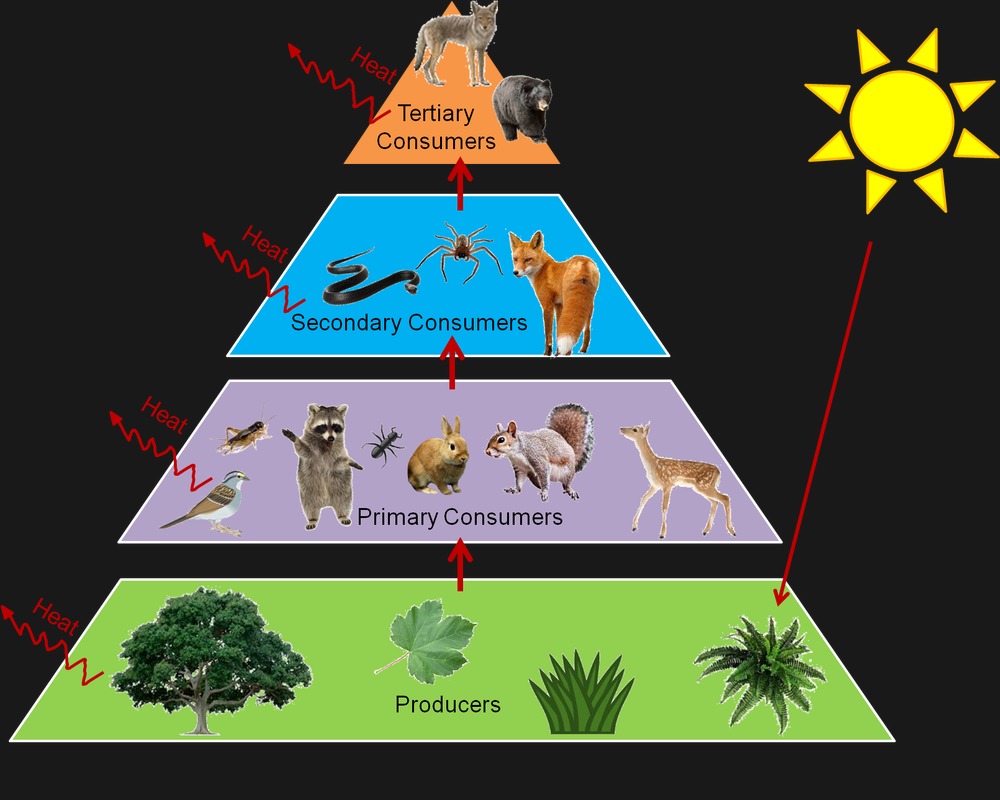
We explored the evolution of money a little in the previous section. But money needs some definition. Merriam-Webster defines money simply as a medium of exchange. Forbes provides essentially the same definition, with a deeper explanation of what is known as “fiat money”, that is, money backed up only by faith in the issuer; in our case, the Federal Reserve system and the government of the United States. Most definitions of money revolve around these basic concepts: medium of exchange, unit of account, and store of value. The mechanism for the buying and selling of products and services is the main way we look at money. However, there are alternative ways to look at our relationship to money.
The Trophic Theory of Money
The word “trophic” refers to nutrition. In ecology it pertains to the nutrition of the 3 levels of the food chain in an ecosystem. In the field of Ecological Economics, the theory has been applied to money. In ecology, trophic levels are typically depicted as a pyramid structure of producers and consumers. In his theory, Brian Czech connects the value of money to the impact on the environment. as in the ecological version where plants are the producers, enabling all consumption, in Czech’s theory, farmers are the enablers of all “higher” economic activity, such as manufacturing, finance, and the like. This theory looks beyond the idea of money as simply a medium of exchange, extending the definition to include its effect on Nature.

The environmental, economic, and social challenges we face are systemic, but inevitable. The notion of TINA, that “there is no alternative” is not just untrue, but destructive; destructive to our environment, our health, and our lives. There are alternative ways to look at everything, including money.
Modern Monetary Theory (MMT)
Let’s start with some definitions and descriptions of what MMT is about. This is a description of MMT from Forbes magazine.
Many establishment economists defend the economic system as it is currently structured. After all, it has worked reasonably well for some over the centuries. But as we have seen in the chart at the beginning of this section, it is not working terribly well for roughly half the U.S. population. And as we have all heard and read, income inequality is the greatest it has been in over 100 years, and wealth is increasingly concentrated in fewer and fewer hands.
The history of U.S. economic crises is long and has had serious negative effects on the majority of working and low income Americans. The mortgage crisis of 2007 followed by the 2008 financial meltdown are only 2 of the most recent economic downturns to stress the American worker and increase economic inequality. The economic crisis spurred by the coronavirus outbreak at the beginning of 2020 and the lack of sufficient response by state and federal government has only exasperated people’s concern about their economic future. And although we are told the stock market is doing very well, it is equally true that the stock market is not the economy.
But the debt ceiling crisis of 2011 brought the issue of money and the money supply to the forefront. That was the year Representative Dennis Kucinich put forward his aforementioned NEED Act. And the beginning of a renewed interest in alternative economics and monetary policy.
Economist Stephanie Kelton coined the term “Modern Monetary Theory”. Here she explains the theory:
The issue, from the MMT viewpoint then is the interconnection of banking and the money supply. Essentially we cannot have money in the economy without incurring debt. The Kettle Pond Institute’s Joe Bongiovanni, in his essay The Problem with Money and Banking puts it this way:
It is that ‘No bank lending = no money
How we got to this point is an interesting journey. In this lecture, documented in a series of 9 video clips, Bongiovanni describes the history of the monetary system from colonial American to present day. In this segment, he explains the function of the Federal Reserve banking system, created by an act of congress in 1913:
It is instructive that something so basic in our lives, money, has a history and a life that has been largely obscured from our inquiry. Even in business journals, the very basics of the Federal Reserve system are not questioned or even examined. The Fed’s policies are sometimes debated; whether to raise interest rates or pump more money into the economy for example. But whether the Fed’s existence is a benefit is not argued. Perhaps, as capitalism works for fewer and fewer people, that silence will be challenged.
Another question that has seldom been asked is that of the nature of money itself. Throughout history, many items have been used as a medium of exchange. They are explored in our next section on money: Alternative Currencies.




